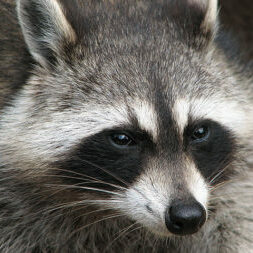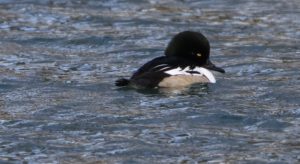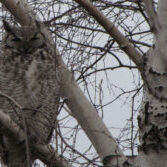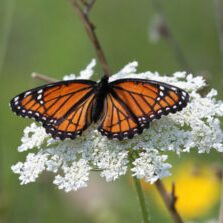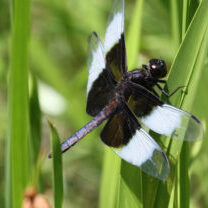Take a second look …
The yellow eyes of the Saw-whet Owl are so startling, their gaze so steady, that we tend to ignore everything else. It’s easy to miss the trace of blood just below the owl’s bill, a smear of something that changes the way we look at the bird, that deepens our understanding of it. What discoveries might we make if we took that second look more often, if we trained ourselves to see?
Latest Posts
An Odd Duck: But a strangely beautiful hybrid
For the second year in a row, a rare hybrid duck has decided to spend the winter at Ashbridges Bay on Toronto’s waterfront. Last year, this male duck, or drake, was still a juvenile and had a juvenile’s dull-colored plumage. This year, it has acquired its adult breeding plumage, and, as the photo above shows, it’s a remarkable looking bird, with a dramatic black crest and rust-coloured flanks. Its parentage brought together two very different types of duck. The Common Goldeneye (Bucephala clangula) is a broad-shouldered bruiser of a diving duck patterned in black and white. It has a blunt … Read more
Read MoreA Word to My Readers
When I started this blog three-and-a-half years ago, my goal was simple and not terribly ambitious. I wanted to contribute a new entry once a month, every month. It didn’t matter to me whether the entries were long or short; it didn’t even matter whether their quality was first-rate or simply mediocre. I thought the discipline involved with writing about something new every month was the main thing. Over time, if I kept to this schedule, the quality would even out, and I’d find myself participating in a certain process of discovery. That is, I’d figure out what mattered enough … Read more
Read MoreAudubon Draws a Nude: A Commission He Couldn’t Refuse, Part Two
I spent a year at the University of Toronto reading the epic poem Beowulf in the original Anglo-Saxon. The prof for that class was Laurence K. Shook, a Basilian priest who had a special interest in the riddles contained in an Old English manuscript called the Exeter Book. These riddles all take the form of short poems in alliterative verse, and none of them comes with a solution. Shook believed several of the riddles referred to birds that were common in England during Anglo-Saxon times. One evening when Father Shook was talking about the riddles, one of my classmates snickered. … Read more
Read More
